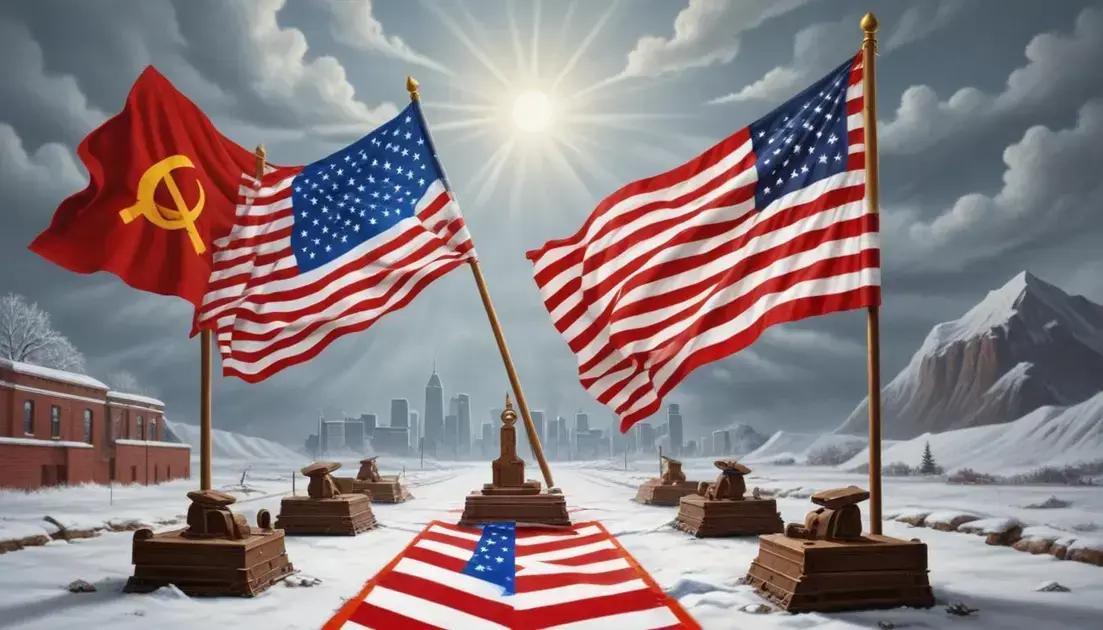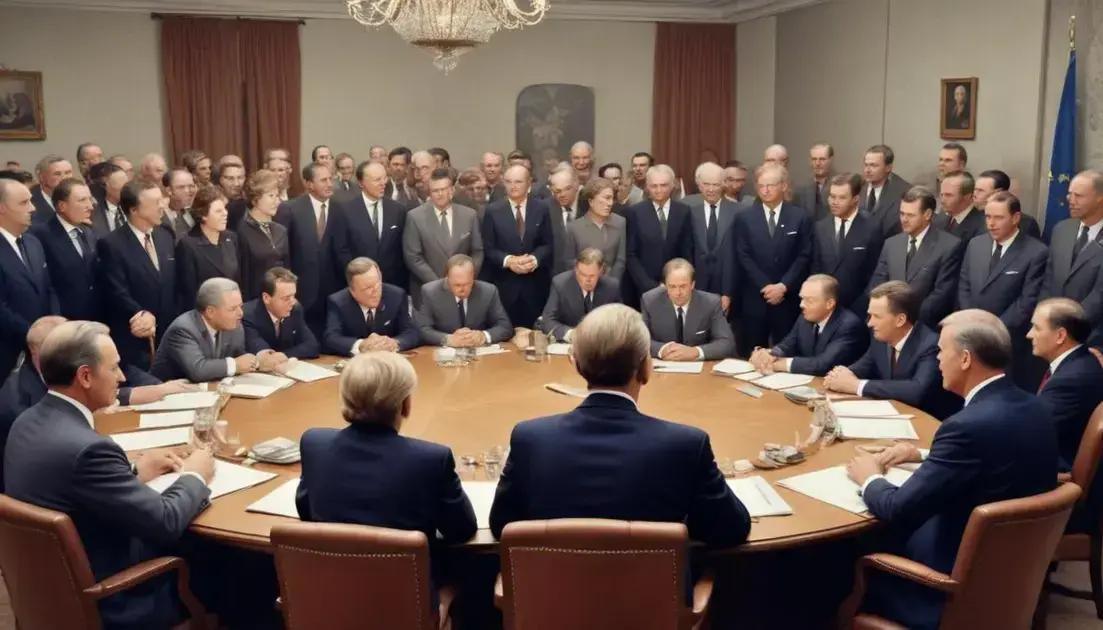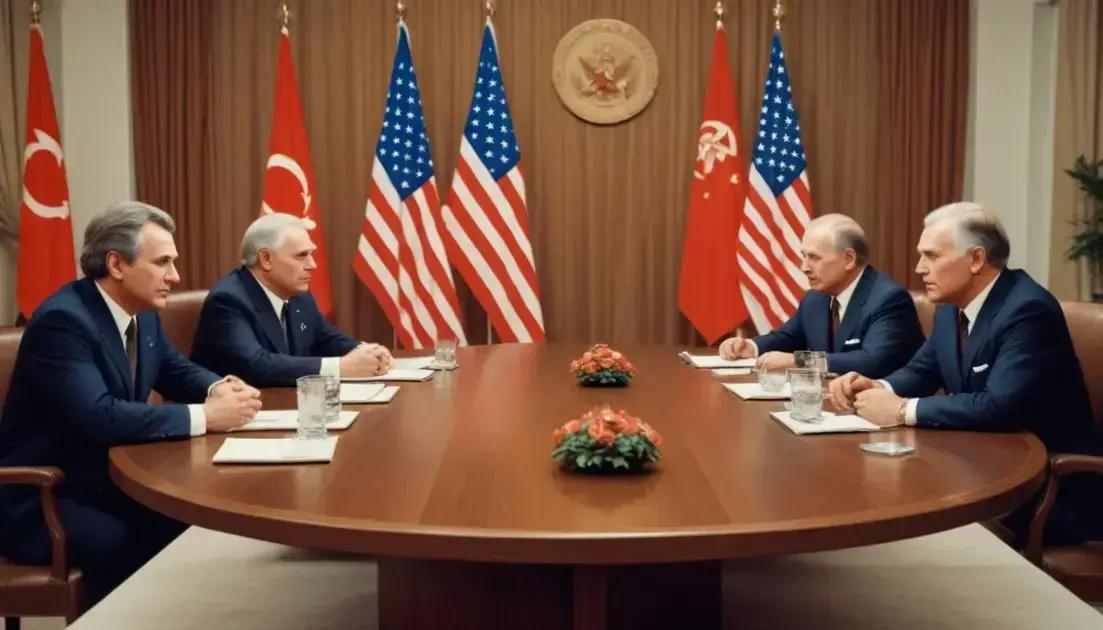
Cold War: The World Divided Between USA and USSR
The Cold War was a period of intense rivalry between the USA and USSR, characterized by the nuclear arms race, proxy wars, and escalating tensions. Key events, such as Gorbachev’s reforms and the fall of the Berlin Wall, ultimately led to a thaw in relations and the dissolution of the Soviet Union in 1991. This historical struggle not only shaped global politics but also left lasting lessons on the importance of diplomacy and understanding in preventing future conflicts.
Welcome to the gripping era of the Cold War, a period that reshaped global relations and politics. Curious about how two superpowers, the USA and USSR, maneuvered?
The ideological divide
The Cold War created a huge ideological divide that split the world in two. On one side, you had the USA promoting capitalism and democracy. On the other side, the USSR pushed for communism and a centralized economy. This divide influenced countries everywhere, making global politics tense and unpredictable.
What is Ideology?
Ideology is a set of beliefs or ideas that guides how societies are organized. During the Cold War, these beliefs were vastly different. Capitalism supports private ownership and individual freedom. In contrast, communism focuses on shared ownership and control by the state.
How the Divide Affected Countries
This ideological divide led to various conflicts. Countries were often caught in the middle, having to choose a side. Many nations in Latin America, Africa, and Asia became battlegrounds for influence and power between the two superpowers.
Symbolism of the Divide
Visually, the divide was clear. Think about the Berlin Wall, which physically and symbolically split East and West. It stood for the broader struggle between two ways of living. Walls and borders became more than just geography; they represented deep ideological beliefs.
Everyday Impact
This divide affected everyday life too. People lived in fear of nuclear war. Governments made decisions based on ideology, often at the expense of their people’s needs. Ordinary citizens found themselves embroiled in a global struggle they had little control over.
Tensions between superpowers
The Cold War was marked by high tensions between superpowers. The USA and USSR were like rivals in a never-ending contest. They wanted to prove their ideologies, military might, and technological advancements. This led to a series of events that kept the world on edge.
Proxy Wars
One way these tensions showed up was through proxy wars. Instead of fighting directly, both superpowers supported different sides in conflicts around the world. This included wars in Korea, Vietnam, and Afghanistan, where local struggles became battlegrounds for their power.
Nuclear Arms Race
Another major concern was the nuclear arms race. Both the USA and USSR built vast arsenals of nuclear weapons. This created a fear of total destruction if war broke out. Each side wanted to be more powerful than the other, leading to a dangerous standoff.
The Role of Espionage
Espionage or spying was another tool used during this period. Both sides sent spies to gather information. They also tried to disrupt each other’s plans. This created a web of mistrust that made tensions even worse.
Diplomatic Maneuvers
Diplomacy played a big role too. Leaders held summits to discuss arms reduction. Events like the Cuban Missile Crisis pushed the world close to nuclear war. Yet, these moments also showed the importance of talks to avoid complete disaster.
Nuclear arms race
The nuclear arms race was a key feature of the Cold War. Both the USA and USSR built massive stockpiles of nuclear weapons. This race created fear and uncertainty globally. Each side wanted to outdo the other with bigger and better bombs.
What Sparked the Arms Race?
After World War II, the use of nuclear weapons changed everything. The USA had dropped atomic bombs on Hiroshima and Nagasaki. This showed the world the destructive power of nuclear weapons. The USSR felt a need to catch up and develop their own arsenal.
Mutually Assured Destruction (MAD)
The idea of Mutually Assured Destruction came into play. This strategy meant that if one side launched an attack, the other would respond with equal force. The goal was to prevent war by ensuring both sides would suffer devastating losses.
Testing and Treaties
Both countries conducted nuclear tests to show their strength. These tests often took place in remote areas, causing health and environmental concerns. Over time, leaders agreed to treaties like the Nuclear Non-Proliferation Treaty to limit the spread of nuclear weapons.
Effects on Society
The arms race affected daily life. People lived with the fear of nuclear war. Schools even held drills to prepare for attacks. The threat loomed large over everyone, shaping attitudes and politics worldwide.
Proxy wars around the globe
During the Cold War, proxy wars around the globe became common. Instead of fighting each other directly, the USA and USSR supported opposing sides in conflicts. This strategy allowed them to push their interests without direct confrontation.
What is a Proxy War?
A proxy war occurs when two powers use third parties to fight on their behalf. They provide equipment, money, or training to allies in conflict zones. This way, they can influence outcomes without getting their own troops involved.
Notable Proxy Wars
Some of the most famous proxy wars included the Korean War and Vietnam War. In Korea, North was backed by the USSR and China, while South Korea had support from the USA. Vietnam saw the North fighting against American forces, causing deep divisions at home and abroad.
Impact on Other Nations
Proxy wars affected many countries, especially in Africa and Latin America. Governments fought against rebel groups that received backing from either superpower. This caused chaos and sometimes led to long-lasting conflicts that changed nation-states forever.
Civilian Impact
These conflicts didn’t just involve armies. Everyday people faced violence and hardship. Families were torn apart, and economies suffered. The long-term effects of proxy wars are still felt today in many regions.
The eventual thaw and resolution
The Cold War finally saw the eventual thaw and resolution in the late 20th century. This period marked a shift from hostility to cooperation between the superpowers. Many factors led to this change, including economic pressures and social movements.
Gorbachev’s Reforms
One major figure was Mikhail Gorbachev, the leader of the USSR. He introduced policies like glasnost, meaning openness, and perestroika, which aimed at reforming the economy. These changes opened up discussions and reduced tensions with the West.
Diplomatic Engagements
In the 1980s, leaders from both sides started holding high-stakes meetings. These meetings focused on arms control and reducing nuclear stockpiles. Notable agreements included the Intermediate-Range Nuclear Forces (INF) Treaty, which was signed in 1987.
The Fall of the Berlin Wall
The fall of the Berlin Wall in 1989 symbolized the end of the Cold War. People celebrated as they tore down the wall that divided East and West Berlin. This event marked a powerful moment of unity and hope for a peaceful future.
The Collapse of the USSR
By 1991, the Soviet Union officially dissolved. This event ended the geopolitical struggle between the two superpowers. Former Soviet republics gained independence, leading to a new world order with the USA as the dominant power.
Conclusion
In conclusion, the Cold War was a complex period marked by significant events like the nuclear arms race, proxy wars, and the eventual easing of tensions. Understanding these elements helps us see how nations interacted through conflict and diplomacy. The fall of the Berlin Wall and Gorbachev’s reforms played crucial roles in changing the course of history.
Today’s world still carries lessons from this era. The importance of communication, negotiation, and understanding can help prevent future conflicts. As we look back at the Cold War, we can learn how peace is achieved through dialogue and cooperation among nations. This reminder is vital as we continue to navigate global relationships in our lives today.


